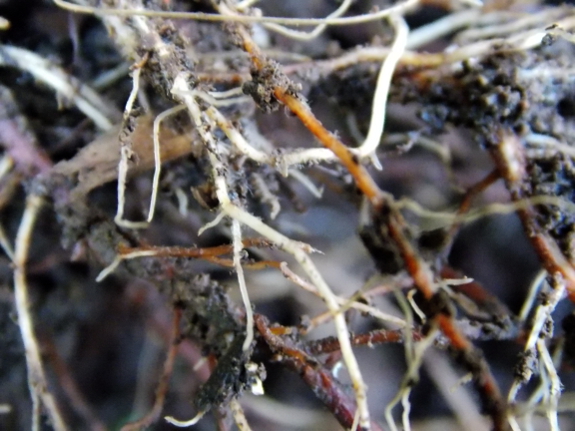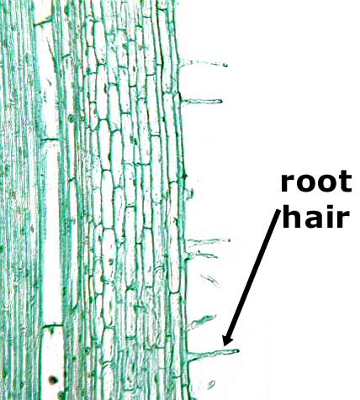
Root hairs

I've been reading a
lot of tidbits about root hairs over the last couple of
years. Various sources have explained that root hairs are
the only parts of a root that take up most nutrients. Others
add that root hairs are only formed on the tips of growing roots
and live for just two to three weeks. Presumably, that means
you should time your compost application for the periods when root
hairs are being actively formed.
Michael
Phillips
asserts that fruit trees go through cycles of root growth,
alternating with  shoot growth, so you
can expect your trees to be actively taking up nutrients primarily
in mid spring, late summer, and fall. Someone else (I think
it was Robert Kourik) explained that tree roots keep growing until
the ground gets below 40 degrees (if my memory serves). By
keeping the soil warm, a good autumn mulch can give your plant
extra growing time, and, similarly, fall-planting (in zone 5 and
warmer) gives trees a jumpstart on the year ahead.
shoot growth, so you
can expect your trees to be actively taking up nutrients primarily
in mid spring, late summer, and fall. Someone else (I think
it was Robert Kourik) explained that tree roots keep growing until
the ground gets below 40 degrees (if my memory serves). By
keeping the soil warm, a good autumn mulch can give your plant
extra growing time, and, similarly, fall-planting (in zone 5 and
warmer) gives trees a jumpstart on the year ahead.
But I felt like I was
missing a critical link in my understanding of root hairs.
For example, are those white roots in the photograph above (from a
black raspberry) root hairs? Wikipedia suggests not, saying
that root hairs are single cells elongating sideways away from the
main root, and are generally invisible to the naked eye. On
the other hand, since new root hairs are found on new roots, and
new roots are white, I suspect I can use color as a rough estimate
of where root hairs are present.
And can I take
Michael Phillips' assertion about seasonality to be true of all
perennials? I'm sure each species has its own cycle of root
growth --- perhaps the only way to know is to keep an eye out for
white roots in the few instances when I'm messing in the dirt
around my woody plants. If anyone has found a source with
data on root growth seasonality for the common fruiting plants,
I'd love to see it!
Want more in-depth information? Browse through our books.
Or explore more posts by date or by subject.
About us: Anna Hess and Mark Hamilton spent over a decade living self-sufficiently in the mountains of Virginia before moving north to start over from scratch in the foothills of Ohio. They've experimented with permaculture, no-till gardening, trailersteading, home-based microbusinesses and much more, writing about their adventures in both blogs and books.
Want to be notified when new comments are posted on this page? Click on the RSS button after you add a comment to subscribe to the comment feed, or simply check the box beside "email replies to me" while writing your comment.

From my studies in forestry root growth and leaf growth do happen at alternate times of the year. Most root growth happens early spring and fall (makes sense since the leaves are pushing all the nutrients back into the roots so that they can have energy for the next year).
I would expect all perennial plants follow the same pattern.